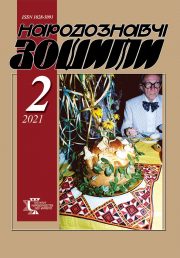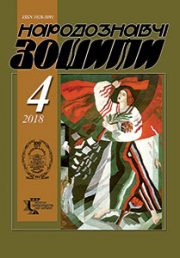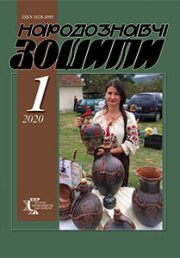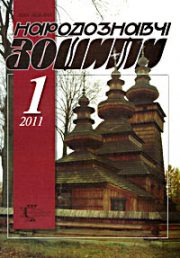The Ethnology Notebooks. 2023. № 4 (172), 1061—1084
UDK [738:39](=161.2):930.2:069(477:100)
DOI https://doi.org/10.15407/nz2023.04.1061
UKRAINIAN FOLK FIGURE EARTHENWARE: HISTORIOGRAPHY AND THE SOURCES OF RESEARCH
IVASHKIV Halyna
- ORCID ID: htps://orcid.org/0000-0003-2359-6735
- Doctor of Sciences in Art Criticism, Senior Scholar,
- Head of the Department «The Centre for Research of Ukrainian Pottery»,
- at the Ethnology Institute of the National Academy of Sciences of Ukraine,
- at the Museum of Ethnography, Arts and Crafts, Folk Art Department,
- 1, Svoboda Ave., 79000, Lviv, Ukraine,
- Contacts: e-mail: halynaivashkiv@ukr.net
Abstract. Ukrainian folk figure earthenware as an original type decorative and applied arts functions according to all the general laws by which folk art develops. The analogues of such earthenware can be traced in works made of wood, metal, stone, gypsum, dough and cheese. There are figure-shaped bowls of open and closed type, zoomorphic and anthropomorphic interior items, namely candlesticks, earthenware money boxes, flower pots, ash trays, small plastic items, pipes, music instruments (okaryna) etc. We can see certain features of figure shapes in architectural earthenware, particularly in formative and decorative bricks, roof tiles, some exterior and interior elements of sacral buildings (reliefs, rosettes, roofs, and floor tiles), chimneys etc. The earthenware plays an important role in church space and liturgy as well as calendar (Christmas, Easter etc.) and family (birth, wedding, and burial) rituals and customs of the Ukrainian people.
The aim of the article is to provide a versatile analysis of historiography and sources that can become a basis for new research into specificity of plastic and relief dйcor as well as figure earthenware. Therefore, we a have a task to be the first to research less known art critical literature, often unknown archive materials, the author’s own field materials collected during expeditions and trips, data from museum and private collections of earthenware etc. This all gives us the opportunity to introduce a large number of earthenware into Ukrainian art criticism. In particular, we mean items from more than a hundred museums of Ukraine (1993—2019), Poland (National Ethnographic Museum in Warsaw (2005), Ethnographic and National Museums in Krakow (1998, 2002), Castle Museum in Јaсcut (2009), Museum of Archaeology and Ethnography in Јodz (2013), Museum of the Lublin Region Countryside in Lublin, 1995, 2005, 2011, 2017 etc), Slovakia (Museum of Folk Architecture and Life in Svidnik, 2014), the russian federation (russian Ethnographic Museum, 2005), China (Museum «Ukraine» in Jinhua, 2016), the USA (Ukrainian Museum in New York, Ukrainian National Museum in Chicago, 2019), over 15 private collections, materials from 9 expeditions and numerous business trips.
The object of research is Ukrainian and foreign scholars’ research into the development of figure earthenware; and the subject of research is defining dominant tendencies in interpreting Ukrainian folk figure earthenware. The methodological basis of the research is the metod of art analysis.
Keywords: figure earthenware, plasticity of dйcor and shape, research, sources, museums, collections.
Received 5.07.2023
REFERENCES
- Orshanskyi, L.V., & Sylko, R.M. (2016). Gottfried Semper and artistic and industrial education of Western Europe and Ukraine. Drohobych [in Ukrainian].
- Stankevych, M. (1992). System of compositional regularities. In Antonovych, E.A., Zakharchuk-Chugai, R.V., & Stankevych, M.E. Decorative and applied art. Lviv [in Ukrainian].
- Peleshchyshyn, M.A. (1996). From the history of the ancient population of Northern Prykarpattia and Western Volyn. Lviv [in Ukrainian].
- Novokhatko, L.M. (Ed.). (2004). Encyclopedia of Trypillia civilization (Vol. 1, book 1; Vol. 1, book 2; Vol. 2). Kyiv [in Ukrainian].
- Verbytskyi, L. (1882). Samples of domestic industry. Clay products of peasants in Rus (Kosiv) (Series V). Lviv [in Ukrainian].
- Verbytskyi, L. (1889). Patterns of household peasant industry in Rus (Series IX). Lviv [in Ukrainian].
- Zaykevych, A.E. (1882). Motifs of the Little Russian ornament of earthenware. Poltava [in Russian].
- Rusov, M. (1905). Earthenware in the village of Opishnia, Poltava region. Materials for Ukrainian-Rus ethnology (Vol. VI, pp. 41—59). Lviv [in Ukrainian].
- (1913). Ukrainian folk art. Series VI: Pottery. Main forms (Issue 1: Types of Ukrainian earthenware). Poltava [in Russian].
- Shukhevych, V. (1901). Hutsulshchyna: in 5 vol.(Vol. IV, part 2, pp. 145—320). Lviv [in Ukrainian].
- Shukhevych, V. (1909, July 17). Participation of Ruthenians in the Industrial and Liturgical Performance. Dilo [in Ukrainian].
- Haberlandt, M. (1911). Austrian folk art from the collections of the Museum of Austrian Folklore in Vienna. Vienna [in German].
- Prusevich, A. (1916). Pottery in the Podolsk province. In Handicrafts of the Podolsk province. Kyiv [in Russian].
- Shulgyna, L. (1929). Pottery in the village Bubnivka in Podillia. Materials for ethnology (Vol. 2, pp. 111—200). Kyiv [in Ukrainian].
- Fride, M. (1928). Shapes and ornaments of crockery from Podillia. Scientific collection of the Leningrad Society of Researchers of Ukrainian History; Literature and Language (Vol. 1, pp. 81—92). Kyiv [in Ukrainian].
- Spaska, E. (1929). Ornament of Bubnivkacrockery. Materials for ethnology (Vol. 2, pp. 201—223). Kyiv [in Ukrainian].
- Aleksandrovych, Yu. (1929). Bubnivkaearthenware. Everyday life. Periodic agency of the All-Ukrainian Ethnographic Society (Vol. 4—5). Kyiv [in Ukrainian].
- Samarin, Yu.A. (1929). Podolsk potters. Moscow [in Russian].
- Geppener, N. (1928). Lavrenyuk-Polyvyanipotters from Zherdeniv. Kyiv [in Ukrainian].
- Spaska, E. (1995). Travels in Chernihiv region; excerpts from diaries, 1921—1926, mainly about Chernihiv pottery. Ukrainian Pottery: National Cultural Yearbook. For the year 1994 (Vol. 2, pp. 337—373). Opishne [in Ukrainian].
- Fride, M. (1926). Pottery in the south of Chernihiv region. Materials on ethnography (Book III, vol. I, pp. 45—58). Leningrad [in Russian].
- Seweryn, T. (1929). Pokuttia folk majolica. Krakow [in Polish].
- Ryzhenko, Ya. (1930). Forms of pottery of Poltava region. Scientific collection of the Kharkiv Research Department of the History of Ukrainian Culture named after Acad. D.I. Bagaliy (Vol. IX, pp. 22—42). Kharkiv [in Ukrainian].
- Sichynskyi, V. (1937). Pottery in the vicinity of the Carpathians (Part 7). Nova khata [in Ukrainian].
- Sichynskyi, V. (1937). Pottery of the Left Bank (Part 8). Nova khata [in Ukrainian].
- Sichynskyi, V. (1937). Ukrainian folk earthenware (Part 2). Nova khata [in Ukrainian].
- Musienko, P.N., & Manucharova, N.D. (Ed.). (1952). Ivan Gonchar. Kyiv [in Ukrainian].
- Dmitriyeva, E.M., & Manucharova, N.D. (Ed.). (1952). The art of Opishnia. Kyiv [in Ukrainian].
- Mateyko, K.I. (1959). Folk earthenware of the western regions of the Ukrainian SSR in the 19thand 20th cc.: historical and ethnographic research. Kyiv [in Ukrainian].
- Gurgula, I., & Chekhovych, S. (1959). People’s masters. Lviv [in Ukrainian].
- Lashchuk, Yu. P. (1956). Hutsul ceramics. Kyiv [in Ukrainian].
- Lashchuk, Yu.P. (1966). Kosiv ceramics. Kyiv [in Ukrainian].
- Lashchuk, Yu.P. (1968). Ukrainian potters. Kyiv [in Ukrainian].
- Goncharov, V.K. (1966). Artistic crafts. In History of Ukrainian art: in 6 vols. Art of the earliest times and era of Kyivan Rus (Vol. 1, pp. 357—392). Kyiv [in Ukrainian].
- Musiyenko, P.N. (1968). Ceramics. In History of Ukrainian art: in the 6th vol. Art of the second half of the 17th—18th centuries (Vol. 3, pp. 322—335). Kyiv [in Ukrainian].
- Lashchuk, Yu.P. (1967). Ceramics.In History of Ukrainian art: in the 6th vol. Art of the 14th — first half of the 17th centuries (Vol. 2, pp. 389—399). Kyiv [in Ukrainian].
- Lashchuk, Yu.P. (1970). Ceramics.In History of Ukrainian art: in the 6th vol. Art of the second half of the 19th—20th centuries (Vol. 4, part. 2, pp. 340—350). Kyiv [in Ukrainian].
- Danchenko, L. (1969). Folk earthenware of the Dnipro region. Kyiv [in Ukrainian].
- Danchenko, L. (1974). Folk earthenware of the Middle Dnipro region. Kyiv [in Ukrainian].
- Sakovych, I.V. (1970). Folk ceramic sculpture of Soviet Ukraine. Kyiv [in Ukrainian].
- Shcherbak, V. (1974). Modern Ukrainian majolica. Kyiv [in Ukrainian].
- Lashchuk, Yu.P., Rozhankivskyi, V.F. (Eds.). (1974). Ukrainian folk earthenware. Ukrainian folk art. Ceramics and glass. Kyiv [in Ukrainian].
- Charnovskyi, O. (1976). Ukrainian folk sculpture. Lviv [in Ukrainian].
- Hnativ, M. (1977). Red horses, 8, 106—113 [in Ukrainian].
- Lashchuk, Yu. (1989). The art of Boiko ceramics. Folk creativity and ethnography, 1, 36—42) [in Ukrainian].
- Lashchuk, Yu. (1961). Image of T.G. Shevchenko in Ukrainian folk earthenware. Folk creativity and ethnography, 1, 86—88 [in Ukrainian].
- Klymenko, O., & Zhulynskyi, M.G. (Ed.). (2012). Pottery and Shevchenko. In the Shevchenko encyclopedia: in 6 vol. (Vol. 2, pp. 126—129). Kyiv [in Ukrainian].
- Ivashkiv, H. Shevchenkiana in Ukrainian ceramics of the 19thand early 21st cc. Ethnology notebooks, 6, 1165—1188 [in Ukrainian].
- Ivashkiv, H. (2021). Painted and relief earthenware with the images of Taras Shevchenko and characters of his works.Interdisciplinary approaches to Russian, eastern European and central Asian studies. Beijing.
- Hudak, V.A. (1974). Creativity of the potters from Bar. Ukrainian art studies (Vol. 6, pp. 146—150). Kyiv [in Ukrainian].
- Hudak, V.A. (1994). Ceramics. Podillya: historical and ethnographic study. Kyiv [in Ukrainian].
- Kuchugura, L.I. (1992). On ceremonial ceramics of Podillya. Problems of ethnography, folklore and social geography of Podillia. Kamianets-Podilskyi [in Ukrainian].
- Pirus, T.P. (1992). Potters of the village of Rakhny Lisovi (past and present). Ethnography of Podillia: Reports of the scientific conference (Part 2, 54—58). Vinnytsia [in Ukrainian].
- Melnychuk, L. (2004). Pottery of Podillia in the second half of the 19th— 20th cc.: historical and ethnographic research. Kyiv [in Ukrainian].
- Klymenko, O. (2006). Centers of Podil pottery in the collection of the Museum of Ukrainian Folk Decorative Art. Museums of folk art and national culture. Collection of scientific works edited by M.R. Selivachov, Doctor of Art Studies. Kyiv [in Ukrainian].
- Lashchuk, Yu. (1960). Transcarpathian folk earthenware. Uzhhorod [in Ukrainian].
- Spaska, E. (1929). A jug with a cross (Study from the series «Chernigiv Pottery»). Materials for ethnology and anthropology (Vol. 21—22, part 1, pp. 36—41). Lviv [in Ukrainian].
- Orel, L. (1991). Pottery of Right Bank Polissia. Folk creativity and ethnography (Vol. 4, pp. 75—82) [in Ukrainian].
- Sumtsov, N.F. (1902). Essays on folk life: from an ethnographic excursion in 1901 in the Akhtyrsky district of the Kharkov province. Kharkiv [in Russian].
- Sumtsov, M.F. (2002). Slobozhanshchyna. Historical and ethnographic research. Kharkiv [in Ukrainian].
- Babenko, V.A. (1905). An ethnographic essay on the folk life of the Yekaterinoslav region. Yekaterinoslav [in Russian].
- Klymenko, O. (19990. Ostap Nochovnyk. Folk art (Vol. 1—2, pp. 58—59) [in Ukrainian].
- Klymenko, O. (1999). Pottery of the late 19thand early 20th cc. (Innovative direction). Folk art (Vol. 3—4, pp. 43—45) [in Ukrainian].
- Serzhant, L. (2004). Ceramics of Chernihiv Region in the collection of the Museum of Ukrainian Folk Decorative Art. Museum business and museum policy in Ukraine in the 20th century: Collection of scientific works edited by M.R. Selivachov, Doctor of Art Studies. Kyiv [in Ukrainian].
- Danchenko, L. (1982). Ukrainian folk art. Leningrad [in German].
- Tyshchenko, O.R. (1983). Decorative and applied art of the Eastern Slavs and the ancient Rus people (1st c. BC — middle of the 13th c.). Kyiv [in Ukrainian].
- Tyshchenko, O.R. (1992). History of decorative and applied arts of Ukraine (13th—18th cc.). Kyiv [in Ukrainian].
- Koshovyi, O.P. (1988). Construction earthenware of Ukraine. Kyiv [in Ukrainian].
- Golubets, O. M. (1991). Lviv ceramics. Kyiv [in Ukrainian].
- Shmagalo, R.T. (1992). Pottery crafts of Ukraine in the late 19th — early 20th cc. (study of organizational and creative processes). Author. dis. cand. art history. Moscow Higher School of Industrial Art (former Stroganovskoye). Moscow [in Russian].
- Shmagalo, R. (2021). Is modern decorative and applied art useful (on the occasion of two anniversaries). Art (Vol. 1, pp. 18—22) [in Ukrainian].
- Noga, O., & Shmagalo, R. (1994). Between East and West. Ceramics of Halychyna of the late 19thand early 20t cc. in the context of international relations. Contacts and interactions. Lviv [in Ukrainian].
- Stankevych, M. (1992). Artistic ceramics. In Antonovych, E.A., Zakharchuk-Chugay, R.V., Stankevych, M.E. Decorative and applied art. Lviv [in Ukrainian].
- Stankevych, M. (2004). Authenticity of art. Lviv [in Ukrainian].
- Poshyvaylo, O.M. (1993). Ethnography of Ukrainian Pottery: Left Bank Ukraine. Kyiv [in Ukrainian].
- Poshivaylo, I. (2000). Phenomenology of pottery: Semiotic and ethnological aspects. Opishne [in Ukrainian].
- Melnychuk, L. (2004). Pottery of Podillia in the second half of the 19th—20th cc: historical and ethnographic research. Kyiv [in Ukrainian].
- Selivachov, M. (2005). Lexicon of Ukrainian ornamentation (iconography, nomination, stylistics, typology). Kyiv [in Ukrainian].
- Shmagalo, R. (2005). Art education in Ukraine in the mid-19th — mid-20th cc: structuring, methodology, artistic positions. Lviv [in Ukrainian].
- Ivashkiv, H. (Ed.). (2007). Vasyl Shostopalets and Sokal ceramics. Lviv [in Ukrainian].
- Ivashkiv, H. (2007). Decor of Ukrainian folk earthenware of the 16th — first half of the 20th centuries. Lviv [in Ukrainian].
- Ivashkiv, H. (2010). Collection of ceramics by Petro Linynskyi. Scientific and artistic publication. Lviv [in Ukrainian].
- Ivashkiv, H., & Lozynskyi, T. (Eds). (2012). Painted ceramics of Kosiv and Pistyn of the 19th— early 20th cc. Lviv [in Ukrainian].
- Klymenko, O., Serzhant, L., & Istomina, G. (2009). Pottery. History of decorative art of Ukraine (Vol. 3, pp. 121—160). Kyiv [in Ukrainian].
- Klymenko O., Serzhant L., Istomina G. (2009). Pottery. History of decorative art of Ukraine. Art of the 19th century. Folk art and crafts of the 20th century (Vol. 4, pp. 121—160). Kyiv [in Ukrainian].
- Motyl, R. (2011). Ukrainian smoked earthenware of the 19th — early 21st cc. History. Typology. Artistic features. Lviv [in Ukrainian].
- Shmagalo, R. (1994). Sacral function in Ukrainian ceramics of the 19th and early 20th cc. Ukrainian sacred art: traditions, modernity, perspectives. Materials of the International Scientific Conference (Lviv, May 4—5, 1993). Lviv [in Ukrainian].
- Zholtovskyi, P.M. (1967). Metal. History of Ukrainian art: in 6 vol. Art of the 14th — first half of the 17th century (Vol. 2, pp. 377—388). Kyiv [in Ukrainian].
- Zholtovskyi, P.M. (1968). Metal. History of Ukrainian art: in 6 vol. Art of the 17th—18th centuries (Vol. 3). Kyiv [in Ukrainian].
- Zholtovskyi, P.M. (1973). Artistic casting in Ukraine of the 14th—18th cc. Kyiv [in Ukrainian].
- Petrenko, M.Z. (1970). Ukrainian goldsmithing of the 16th—17th cc. Kyiv [in Ukrainian].
- Bonkovska, S. (2002). Sacred vessels of the princely age: tectonics, iconography, symbolism. Art studies’02. Lviv [in Ukrainian].
- Klimashevskyi, A. (2000). The development of the interior decoration of Ukrainian wooden churches until the early 19thc. Art studies 2000. Lviv [in Ukrainian].
- Taras, Ya. (2006). Ukrainian sacred wooden architecture: dictionary-reference. Lviv [in Ukrainian].
- Taras, Ya. (2007). Sacred wooden architecture of the Ukrainian Carpathians. Cultural and traditional aspect. Lviv [in Ukrainian].
- Stankevych, M. (2002). Ukrainian artistic wood of the 16th—20th cc. Lviv [in Ukrainian].
- Odrekhivskyi, R.V. (2017). The art of wood carving in Halychyna as a phenomenon of sacred culture of Ukraine (19th — first half of 20th cc.). Dissertation dr. of Art. Kyiv [in Ukrainian].
- Bolyuk, O. (2020). Artistic wood in churches (based on materials from the western regions of Ukraine). Lviv [in Ukrainian].
- Kara-Vasylyeva, T. (1996). Liturgical sewing of Ukraine of the 17th—18th cc.: Iconography, typology, stylistics. Lviv [in Ukrainian].
- Nikorak, O.I. (2004). Ukrainian folk fabric of the 19th—20th cc.: Typology, localization, artistic features (Part I: Interior fabrics (based on materials from the western regions of Ukraine). Lviv [in Ukrainian].
- Bonkovska, S. (2000). Artistic features of sacred dishes of the second half of the 17th— early 18th cc. Formation of the main types, tectonics, decoration. Ethnology notebooks, 3, 487—507 [in Ukrainian].
- Mozdyr, M.I. (1980). Ukrainian folk wooden sculpture. Kyiv [in Ukrainian].
- Bonkovska, S., & Stankevych, M. (Ed.). (2006). Candlesticks. In Stankevych, M. Dictionary of Ukrainian sacred art. Lviv [in Ukrainian].
- Mezentseva, H.I. (1973). Ancient Rus ceramic lamps and candlesticks. Archeology, 10, 72—77 [in Ukrainian].
- Shulgyna, L. (1929). Lighting devices in the village Bubnivka in Podillia. Materials for ethnology (Vol. 2, pp. 52—68). Kyiv [in Ukrainian].
- Figol, M. (1997). The art of ancient Halych. Kyiv [in Ukrainian].
- Lashchuk, Yu.P. (Ed.). (1976). Oleksa Bakhmatiuk. Album. Kyiv [in Ukrainian].
- Lashchuk, Yu. (1998). Pokuttia ceramics. Opishne [in Ukrainian].
- Stankevych, M. (1992). Artistic ceramics. In Antonovych, E.A., Zakharchuk-Chugai, R.V., Stankevych, M.E. Decorative and applied art. Lviv [in Ukrainian].
- Slobodyan, O. (2004). Pistyn ceramics of the 19th — first half of the 20th cc. Kosiv; Chernivtsi [in Ukrainian].
- Kolupayeva, A. (2004). Ukrainian sacral ceramics. Notes of the Scientific Society named after Shevchenko. Proceedings of the Commission of Fine and Applied Arts (Vol. ССХLVІІІ, pp. 231—256). Lviv [in Ukrainian].
- Ivashkiv, H. (2010). Earthenware candlesticks from the collection of Petro Lininskyi. Art studies’10. Lviv [in Ukrainian].
- Ivashkiv, H. (2010). Oleksa Bakhmatiuk’s candlesticks. History of religions in Ukraine. Scientific yearbook: in 2 books. Lviv [in Ukrainian].
- Ivashkiv, H. (2020). Sacred ceramics from Ivan Levynskyi’s factory in Lviv (marking the 100th anniversary of his death). Ethnology notebooks, 1 (151), 93—108) [in Ukrainian].
- Markovych, M. (2003). Renaissance and Baroque lamps. Art studies’03. Lviv [in Ukrainian].
- Markovych, M. (2004). Typology and tectonics of artistic lamps. Ethnology notebooks, 5—6, 724—729. [in Ukrainian].
- Markovych, M. (2005). Artistic features of Ukrainian lamps of the 12th—19th cc. Art studies’05. Lviv [in Ukrainian].
- Markovych, M. (2008). Lamps of the Middle Ages. Art studies’08. Lviv [in Ukrainian].
- Ivashkiv, H. (2012). Earthenware floor candlesticks of the 19th—20th cc.: typology and artistic structure. Art studies’12. Lviv [in Ukrainian].
- Noga, O. (1993). Ivan Levynskyi: artist, architect, industrialist, teacher, public figure. Lviv [in Ukrainian].
- Petryakova, F. (2001). Earthenware crosses, lamps, household icons of Kyiv-Mezhyhirya (1840—1850). History of religions in Ukraine. Proceedings of the 11th international scientific conference (May 16—19, 2001): in 2 books. (B. 2, 336—342). Lviv [in Ukrainian].
- Ivashkiv, H. (1997). The cross in Ukrainian folk ceramics of the late 19th c. — early 20th c. (based on the materials of the folk ceramics fund of Museum of Ethnography and Crafts). Ukrainian Christology. Special edition of «Ethnology notebooks». Lviv [in Ukrainian].
- Ivashkiv, H. (2007). On the issue of clay diskos: form, decoration. History of religions in Ukraine. Scientific yearbook (Book I, pp. 78—84). Lviv [in Ukrainian].
- Ivashkiv, H. (2008). Function, typology, and artistic features of clay crosses in Ukraine. Ethnology notebooks, 1—2, 97—105. Lviv [in Ukrainian].
- Ivashkiv, H. (2008). Earthenware iconostases, reliefs, icons. History of religions in Ukraine. Scientific yearbook (Book II, pp. 702—709). Lviv [in Ukrainian].
- Ivashkiv, H. (2009). Liturgical earthenware crosses. Bulletin of the Carpathian University. Art studies (Vol. ХV—XVI, pp. 15—21). Ivano-Frankivsk [in Ukrainian].
- Ivashkiv, H. (2009). Earthenware crosses: function, typology, decoration. History of religions in Ukraine. Scientific yearbook (Book II, pp. 451—456). Lviv [in Ukrainian].
- Ivashkiv, H. (2009). Ritual and ceremonial ceramics of Oleksa Bakhmatiuk. Apologist. Christian sacred tradition: faith, spirituality, art, 1—4, 191—196 [in Ukrainian].
- Ivashkiv, H. (2012). Ceramics in the ritual of the Divine Liturgy. Ethnology notebooks, 3, 497—516 [in Ukrainian].
- Kolupayeva A. (2006). Household censers, incense burners (to the typology of Ukrainian ceramics). Ethnology notebooks, 1—2, 84—97 [in Ukrainian].
- Kolupayeva, A. (2007). Sprinklers (baptisms) in Western Ukrainian ceramics. Ethnology notebooks, 3—4, 321—330 [in Ukrainian].
- Kolupayeva, A. (2009). On the study of porcelain and earthenware items for church purposes. Ethnology notebooks, 3—4, 401—417 [in Ukrainian].
- Kolupayeva, A. (2012). To the history of church and ceremonial ceramics in Ukraine (11th — early 21st cc.). Ethnology notebooks, 3—4, 467—496 [in Ukrainian].
- Kaindl, R.F. (2000). The Hutsuls: their life, customs and folk tales. Chernivtsi [in Ukrainian].
- Shukhevych, V. (1899). Hutsulshchyna (Materials for Ukrainian-Rus ethnology): in 5 vol. (Vol. 1). Lviv [in Ukrainian].
- Ivashkiv, H. (2015). Ukrainian folk ceramics in the rites of the Christmas cycle. Spheres of Culture (Vol. ХІ). Lublin [in Ukrainian].
- Ivashkiv, H. (2016). Earthenware products as attributes of Easter rituals. Spheres of Culture (Vol. ХІV). Lublin [in Ukrainian].
- Ivashkiv, H. (2016). Earthenware products in wedding rituals of Ukrainians. Scientific notes of Ternopil National Pedagogical University named after Volodymyr Hnatyuk. Series: Art history, 1 (Issue 34, pp. 187—194). Ternopil [in Ukrainian].
- Ivashkiv, H. (2019). Earthenware products in birth and funeral rites. Scientific notes of Ternopil National Pedagogical University named after Volodymyr Hnatyuk. Series: Art history, 2 (Issue 41, pp. 148—157). Ternopil [in Ukrainian].
- Ivashkiv, H. (2019). Functions and Artistic Specificity of Folk Earthenware in Customs and Rituals of the Calendar Cycle of the Ukrainians. EtnoAntropologia (Vol. 7, pp. 85—101).
- Potebnya, A.A. (2000). Symbol and myth in folk culture. Moscow [in Russian].
- Potebnya, A.A. (1865). On the mythical meaning of some rituals and beliefs. Moscow [in Russian].
- Hrushevska, K. (1924). From the primitive culture. Investigations and additional information by Kateryna Hrushevska. Kyiv [in Ukrainian].
- Mogachevich, I. (1853). Kobylya village. Volyn province, Novgorodvolynsky district. Ethnographic collection published by the Imperial Russian Geographical Society (Vol. I, pp. 294—312). Saint Petersburg [in Russian].
- Ivanitsa, A. (1853). Home life of a Little Russian in the Poltava province of the Khorolsky district and other places in the Volyn and Chernihiv provinces. Ethnographic collection published by the Imperial Russian Geographical Society (Vol. I, pp. 337—371). Saint Petersburg [in Russian].
- Afanasiev-Chuzhbinsky, A. (1858). Life of a Little Russian peasant (mainly in the Poltava province). Ethnographic collection published by the Imperial Russian Geographical Society (Vol. ІІІ, pp. 19—46). Saint Petersburg [in Russian].
- Sementovskyi, K. (1843). Remarks on holidays among Little Russians. Kharkiv [in Russian].
- Sementovskyi, K. (1843). Essay on the Little Russian beliefs and customs related to holidays. Molodik for year 1844. Ukrainian literary collection published by I. Betsky (In favor of the Kharkov orphanage). Kharkiv [in Russian].
- Zapaska, Ya.P. (Ed.). (2000). Decorative and applied art. Dictionary: in 2 vol. Lviv [in Ukrainian].
- Stankevych, M. (Ed.). (2006). Dictionary of Ukrainian sacred art. Lviv [in Ukrainian].
- Bossert, H. (1990). Folk Art of Europe. New-York.
- Melegati, L. (1997). Ceramics. Warsaw [in Polish].
- Hyncu, I.G. (1969). Moldavian folk ceramics. Kishinev [in Russian].
- Kotula, F. (1969). Conversations with shells. Rzeszow [in Polish].
- Gajerski, S.F. (1972). Potelych tile-making center in the 15th—18th cc. Quarterly of the History of Material Culture, 3 (Vol. XX, pp. 467—485). Warsaw [in Polish].
- Frys-Pietraszkowa, E. (1973). The pottery center in Lazek Ordynacki and its products against the background of ceramics painted in Poland. Wroclaw; Warsaw; Krakow; Gdansk [in Polish].
- Frys-Pietraszkowa, E., Kunczynska-Iracka, A., & Pokrzywek, M. (1988). Folk art in Poland. Warsaw [in Polish].
- Tomuh, P. (1983). Pottery in Serbia: Ethnographic Museum in Belgrade. Beograd [in Serbian].
- Plickova, E. (1959). Pozdiszov Pottery. Bratislava [in Slovak].
- Polonec, A., & Turzova, M. (1962). Pukan ceramics. Collections of the Department of Ethnography of the Slovak National Museum in Martin. Bratislava [in Slovak].
- Pogan-Berlatan, M., & Karginov, G. (1985). Budapest Museums. Budapest [in Russian].
- (2003). Ukrainian ceramological journal, 2—4 (8—10) [in Ukrainian].
- Sobutska, L. (2015). The contribution of Metropolitan Andriy Sheptytskyi and his family to the formation of the NML folk art collection. Halytska Brama, 2—4, 33—34 [in Ukrainian].







